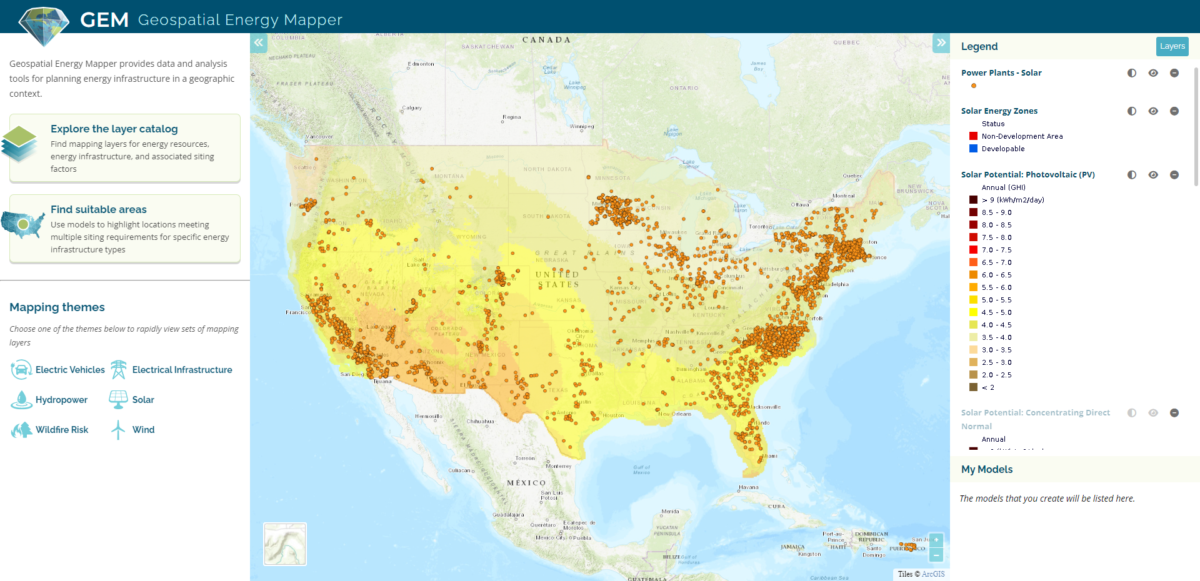A dynamic geospatial mapping tool was developed by Argonne National Laboratory as a free, open resource to identify suitable locations for siting solar, wind, and other clean energy infrastructure projects. Based on desired parameters, the tool will generate a “heat map” of ideal locations.
Users of the Geospatial Energy Map (GEM) can locate sites with high suitability for both clean power generation and energy transmission corridors in the United States. Project developers can browse and download geographical information systems (GIS) data layers or create a customized suitability model to target areas for energy development.
GEM is backed by large sets of relevant geospatial data, including energy resources and infrastructure, demographics, boundaries, utility territories, and more. The tool comes loaded with over 190 data layers, and nearly 100 modeling criteria. Users can select for population density, proximity to nearest substation, slope, wildfire risk and low-income household percentage, and more.

As a new feature, the map can quickly orient itself to a focus technology like solar, wind, or EV charging infrastructure. This allows for a quick loading of multiple data layers directly relevant to the technology under development.
All told, GEM includes preconfigured models for over 40 types of energy infrastructure. Land-based wind turbines or utility-scale photovoltaic solar are two examples of technology presets. The preset data layer groupings provide a starting point that users can then further customize to their desired specifications.
“Choosing where to build utility-scale renewable energy development is a tremendously important decision with effects that reverberate beyond the generation of electricity,” said Michael Levin, a GEM user and Ph.D. student studying renewable energy landscapes at Columbia University. “GEM not only makes energy suitability maps public but allows for the user to customize the model used to produce such a map.”
GEM was first publicly launched in 2013 as the Energy Zones Mapping Tool (EZMT), and has since been redesigned, rebranded and reengineered. It is hosted by the U.S. Department of Energy (DOE) Argonne National Laboratory with funding from the DOE’s Office of Electricity.
“In GEM we applied lessons learned from almost 10 years hosting the EZMT, including making it easier to learn and use, updating the software architecture, and choosing a name fitting its current scope of uses,” said Jim Kuiper, principal geospatial engineer and GEM technical coordinator.
A diverse community of users are expected to make use of GEM, much like its predecessor EZMT. Kentucky’s Office of Energy Policy used the EZMT for prototyping its Solar Site Suitability on Reclaimed Mine Lands tool. Other users include private industry, public service commissions, regional transmission organizations, national laboratories, educational institutions, and energy and natural resource nonprofits.
Argonne will host a virtual tutorial of GEM on Tuesday, January 17th at 2 p.m. CT. Click here to attend the webinar via Microsoft Teams.
This content is protected by copyright and may not be reused. If you want to cooperate with us and would like to reuse some of our content, please contact: editors@pv-magazine.com.









By submitting this form you agree to pv magazine using your data for the purposes of publishing your comment.
Your personal data will only be disclosed or otherwise transmitted to third parties for the purposes of spam filtering or if this is necessary for technical maintenance of the website. Any other transfer to third parties will not take place unless this is justified on the basis of applicable data protection regulations or if pv magazine is legally obliged to do so.
You may revoke this consent at any time with effect for the future, in which case your personal data will be deleted immediately. Otherwise, your data will be deleted if pv magazine has processed your request or the purpose of data storage is fulfilled.
Further information on data privacy can be found in our Data Protection Policy.